In 2020/21, Sporting won the Primeira Liga for the first time in 19 seasons.
Rúben Amorim arrived at Sporting with the then third-highest transfer fee ever paid for a manager. He rightly earned the praise for Sporting’s stunning turnaround, especially given the number of players they sold off with few players coming into the squad.
His title-winning roster consisted mostly of the Verde e Brancos’ famed Academia Sporting players, but the club did manage to bring in some pieces from the outside, one of each was the young Pedro Porro, a right-back who arrived on a 2-year loan from Manchester City. Playing opposite of Nuno Mendes, Sporting’s two wingbacks in Amorim’s 3-4-3 were key contributors to the title-winning side. They were wingback wunderkinds responsible for Sporting’s width in attack.
Mendes has since moved on to PSG, but Porro has returned to the squad and is once again a key player for Amorim, though transfer rumours have linked him to two of the biggest clubs in the world.
The system remains the same, as does Porro’s role. Sporting has reached the knockout rounds of the Champions League for the first time since 2008/09. This tactical analysis will examine Porro’s responsibilities within Amorim’s system, as well as his key attacking attributes. From there, we’ll shine the spotlight on his defensive qualities, including a red flag, then finish up with a look at his Champions League performances and statistics relative to the outside-backs of his suitors.
Key attacking attributes
Playing as a right mid in Sporting’s 3-4-3 system, Porro functions more as a right-wingback than a true midfielder. When Sporting is out of possession, it is common for him and the left wingback to drop in with the back three to give Sporting a 5-2-3 look. Playing higher up the pitch than a traditional outside-back will certainly inflate his attacking statistics, but there’s no doubting his production as the main width provider on Sporting’s right side.
Before jumping into an analysis of Porro’s top attacking traits, let’s first take a look at his statistical profile. The data gives us a look at his percentile ranking relative to the other outside-backs and wingbacks in the Portuguese Primeira Liga.
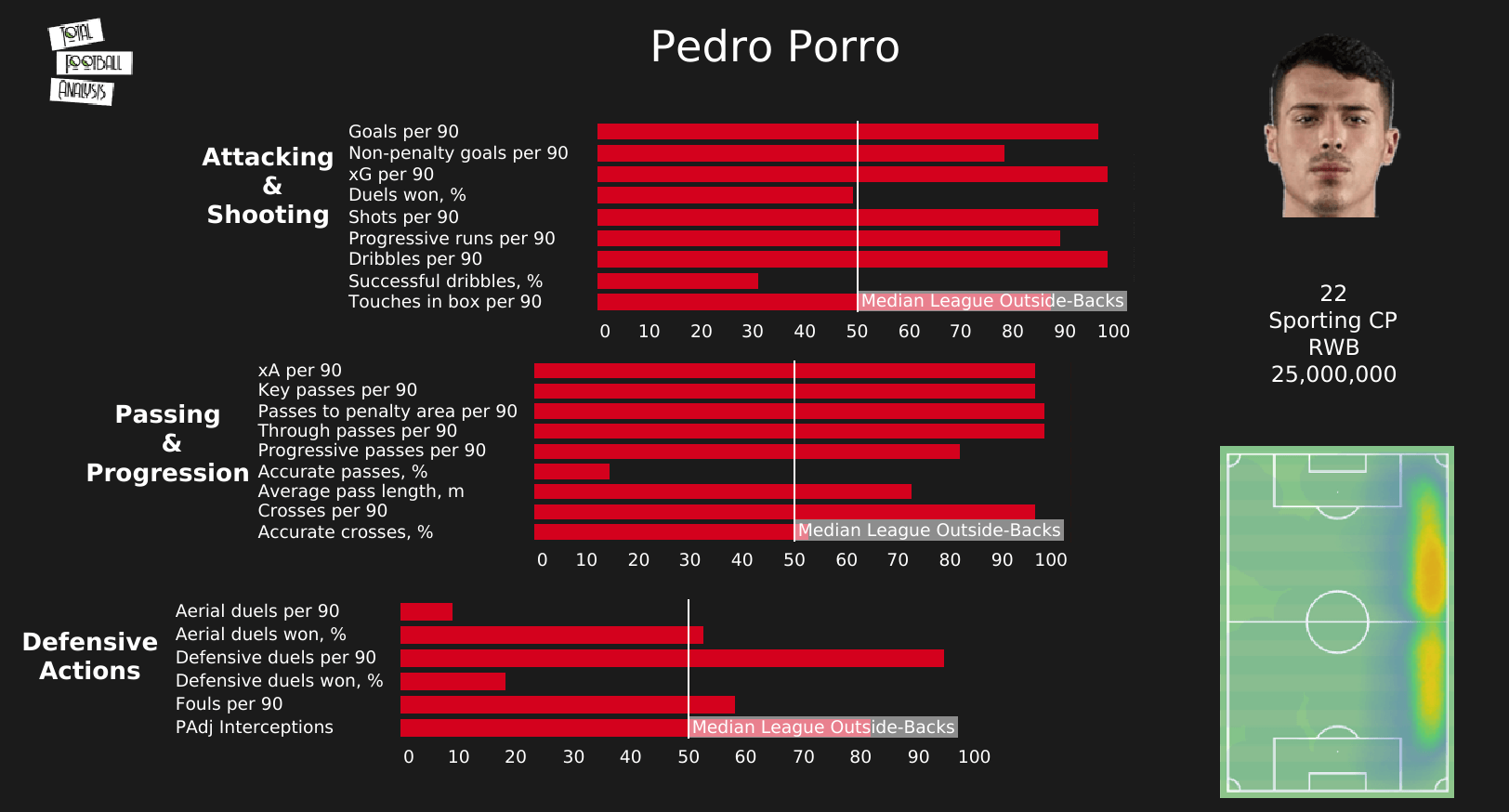
On the first two sections of the dashboard, Porro rates in the 90th percentile or better in nine of the 18 categories. He only fails to reach the league median in three of those, defensive duels won, successful dribbles percentage, and passing accuracy.
The data gives a sense of Porro’s attacking play and contribution to the Lisbon side. As the main width provider on Sporting’s right side, he flies up and down the pitch. Porro’s not just a playmaker in the middle and final thirds; he’s a player who can get into the box to set up a shot or supply the finish himself.
Looking at our first tactical image, we can see Sporting’s 3-4-3 in action. The three forwards are very tightly connected, narrowing the Manchester City backline along the x-axis. With Sporting’s forwards overloading centrally, Porro can then push into a high and wide position to receive a long, diagonal pass from Matheus Nunes.
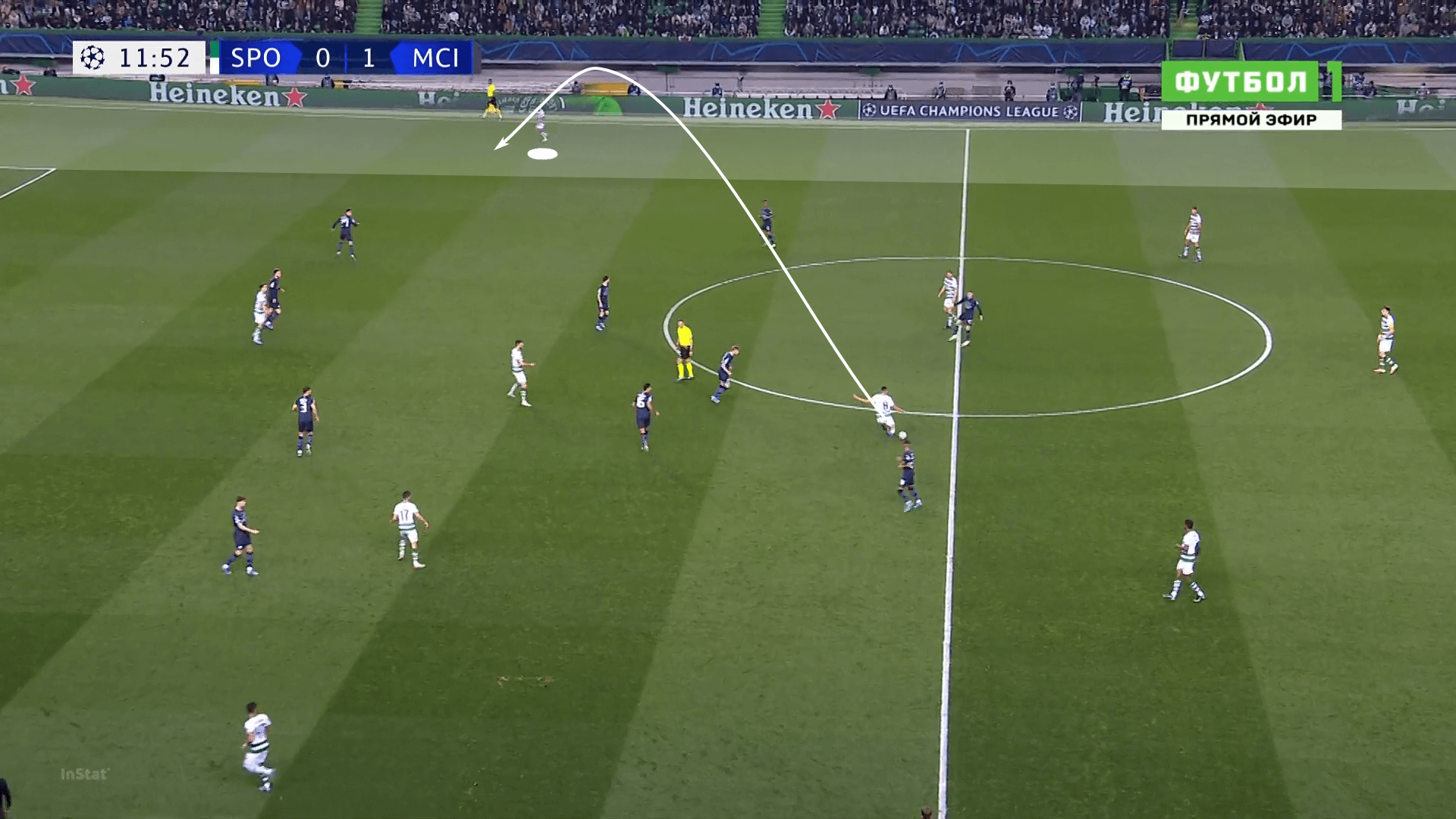
Receiving in that position allows him to get beyond the opposition’s forward and midfield lines, setting up a decisive interaction against opposing left-backs.
In this instance, he faces the Benfica academy product, João Cancelo. With three targets centrally and Ricardo Esgaio pushing higher towards the far post, Sporting has numbers in the box, meaning Cancelo is unsupported by a second defender. Porro has the option to either send in an early cross or engage the Portuguese defender in a 1v1 duel. He opts for the latter, using a clever La Croqueta to put the Manchester City defender off-balance, winning the duel to the inside.
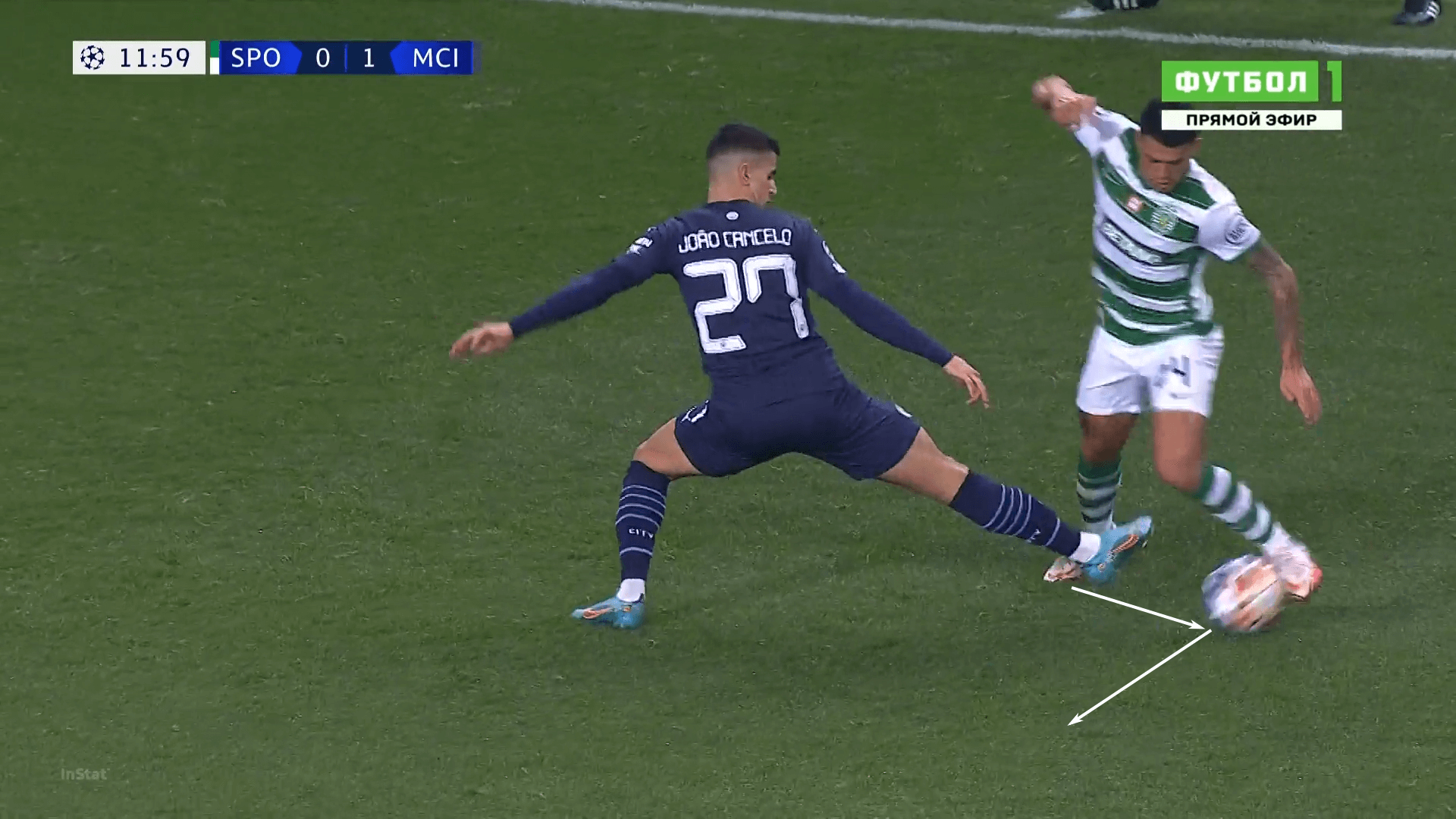
Though Porro’s dribbling success rate is only in the 30th percentile in the Primeira Liga, no outside-back averages more dribbles per 90 minutes than Porro’s 7.43. Even with his high usage rate, he still manages a 53% 1v1 attacking success rate.
When he isn’t running at defenders, Porro will look to use his crossing accuracy to his advantage. Much like his dribbling statistics, Porro produces more crosses P90 than any other outside-back or wingback in the Primeira Liga with 5.57. Even with his high usage he still manages to connect on a third of his crosses, perfectly so with a 33.33% success rate.
Porro is excellent at beating a defender on the dribble, getting into the half-space of the box, and sending a negative cross to his oncoming runners, but he’s not averse to sending crosses from the wings either.
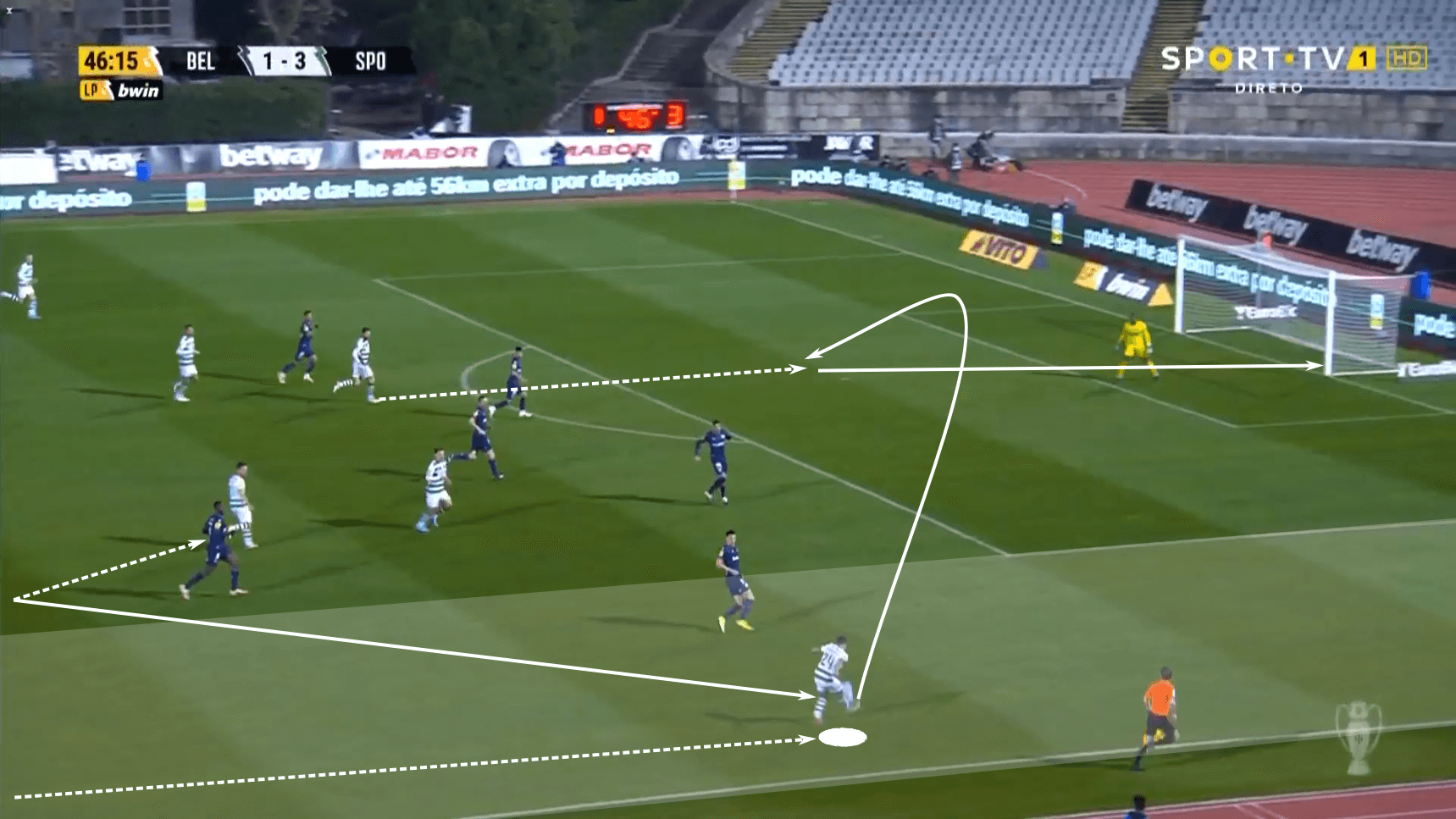
As Sporting counterattacked against Belenenses, Porro was deep in the right wing, maximizing Sporting’s occupation of the x-axis while the hosts moved centrally in an attempt to delay the Leões’ counterattack and cut off access to the high central runners. Porro continued his run forward and was played into space. Rather than challenging his defender to a 1v1 duel, the Spaniard saw his opportunity to send an early cross into the path of Paulinho. The delivery was perfect, allowing the big #9 to time his run to maximize the force of the header. Even though he made contact with the ball from 12 yards out, the bullet header beat the goalkeeper to the near post to extend Sporting’s lead.
One of the best features of Porro’s game is that he’s unpredictable on the wings. Cut off his path to be inside and he’ll drive down the line before sending a cross or trying to turn the corner on the defender. Take away the outside and he’s just as comfortable cutting inside on his weaker left foot. Even though he rarely uses his left foot when his technique requires him to drive the ball over long distances or while maximizing force, he’s very capable of playing accurate passes on the ground, including through balls.
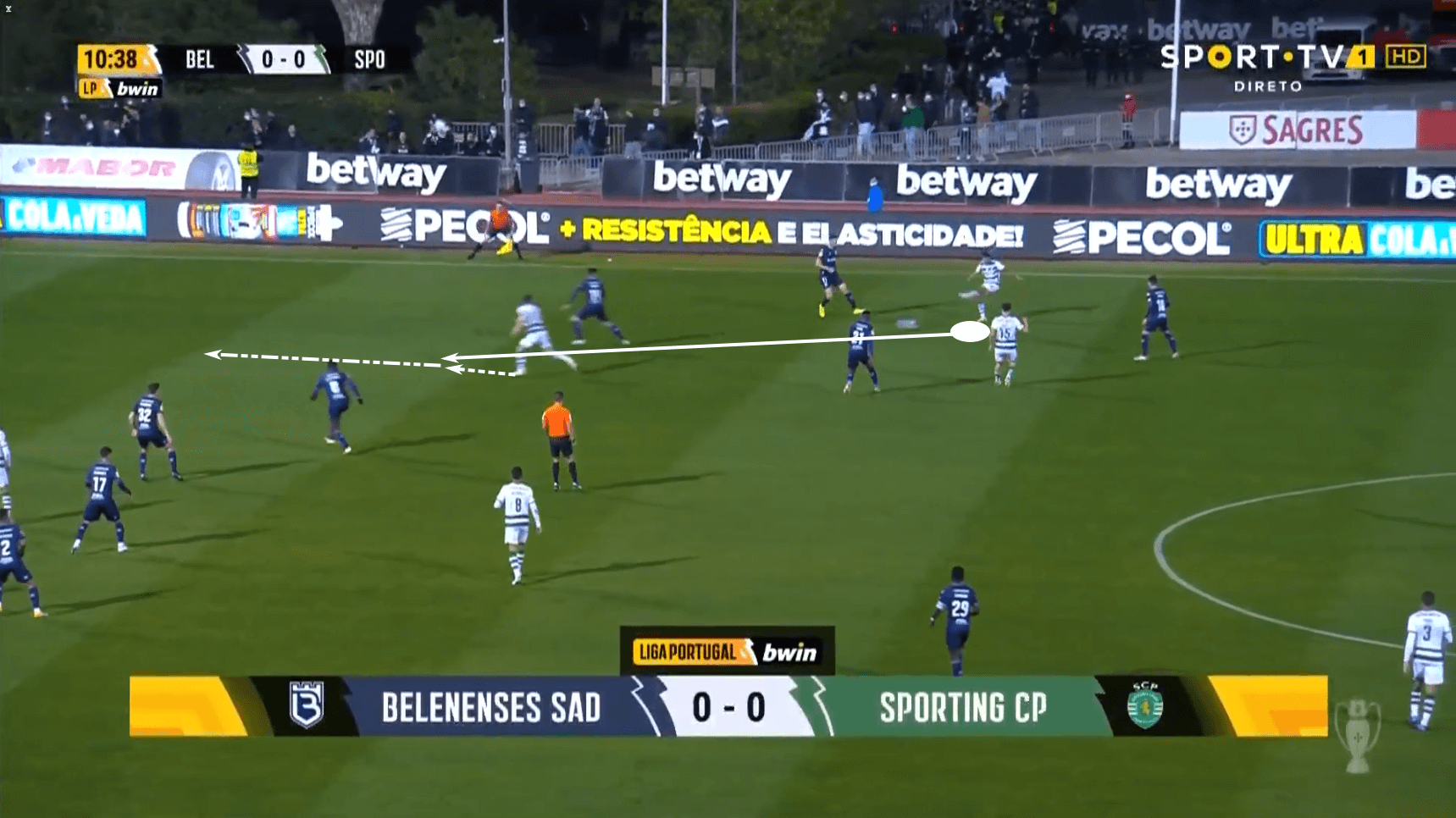
Since Sporting plays with three forwards up top, it’s common to see Porro cut to the inside and then look to play one of his three forwards be on the backline. Pedro Gonçalves is one of the more likely runners behind the line, as you may recall from a previous scout report.
One aspect of his game that’s Sportingistas undoubtedly enjoy is Porro’s willingness to continue with the attack. As Sporting enters the attacking half of the pitch, he’s fully engaged and ready to spring forward into space. In these instances when he has cut inside on his left foot, he can find an intelligent way to stay in the play and support his teammate on the ball.
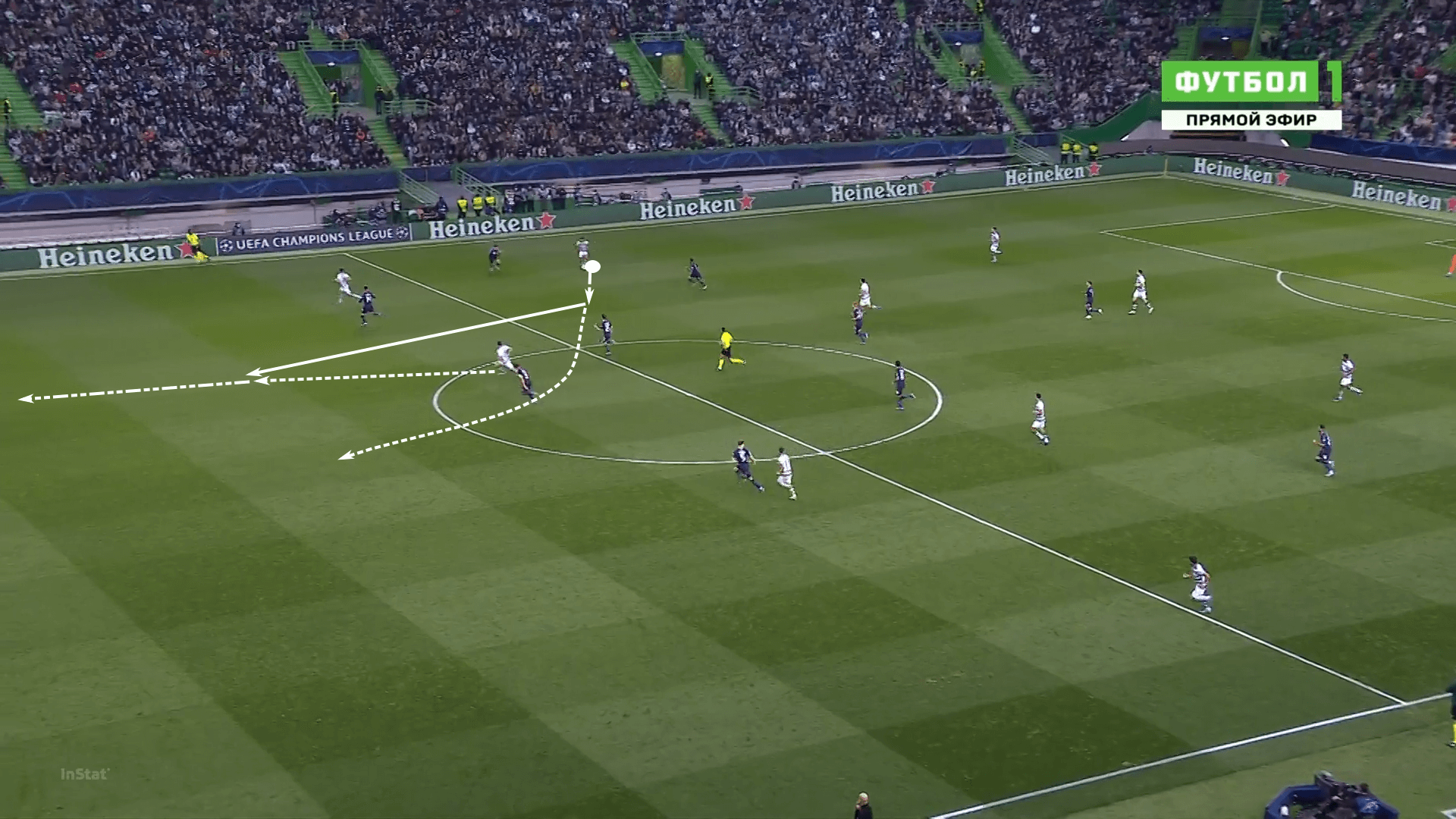
In this sequence against Manchester City in the Champions League Round of 16, Porro played a through pass into the path of Paulinho, who carried the ball just outside the City penalty box. The striker played a challenging ball into the path of Esgaio, who missed his goal attempt, but it’s the run of Porro that deserved more attention in this sequence.
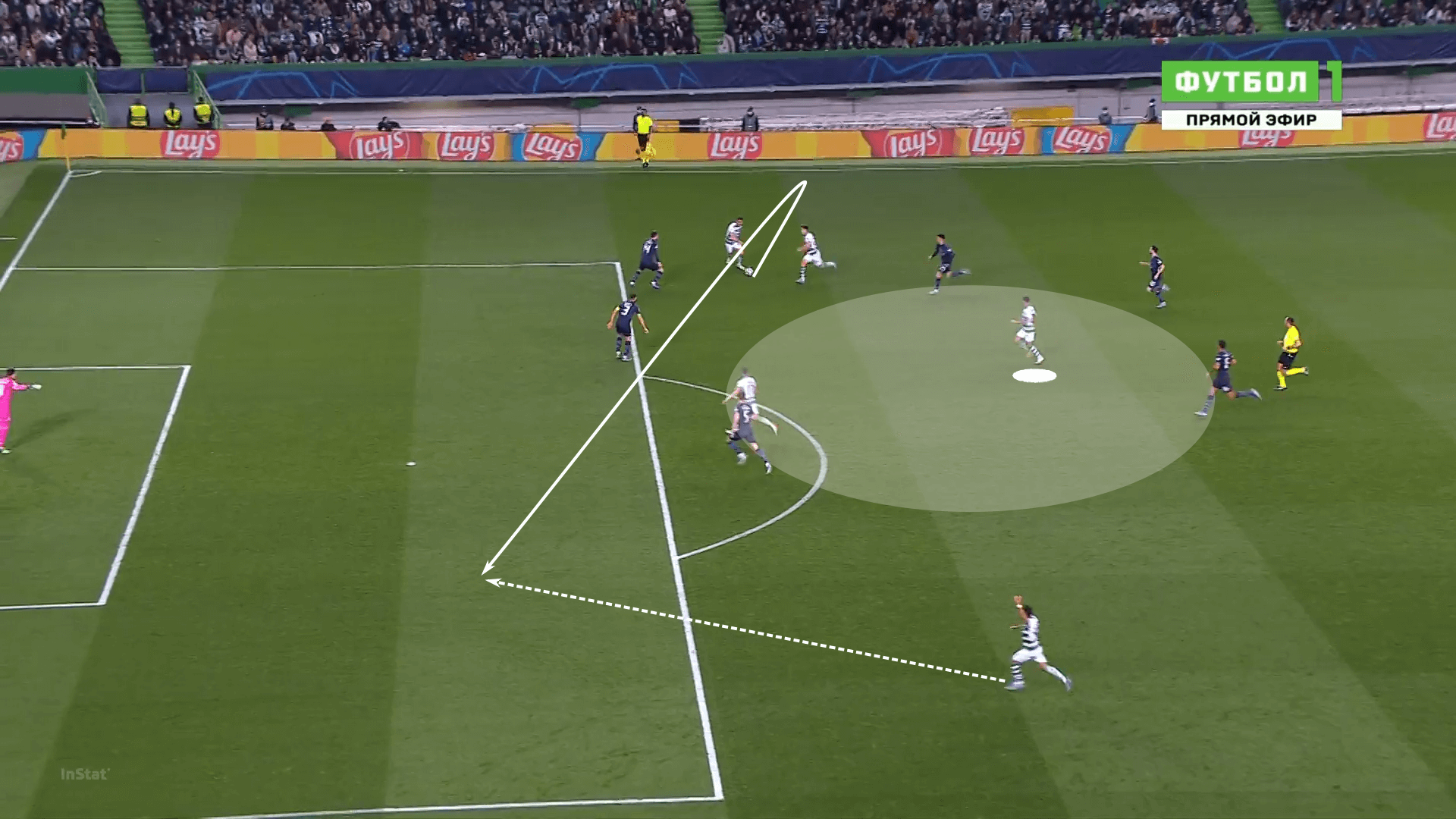
After cutting inside and playing the through ball to Paulinho, he burst into the central channel and found a gap between the Manchester City lines. A simple pass to the Spaniard would have given Sporting a 3v2 centrally. Even if the ball did eventually end up at Esgaio’s feet, receiving a pass on the ground from Porro would have given him better conditions for his shot.
Playing in a high and wide position, especially given the central overload in Sporting’s tactics, Porro enjoys a full view of the pitch with his “paint on the boots” positioning. We’ve seen that he’s comfortable bursting down the wing, cutting inside or playing through balls into his near-sided forwards. We haven’t even discussed his connection with the far-sided forward and left wingback yet.
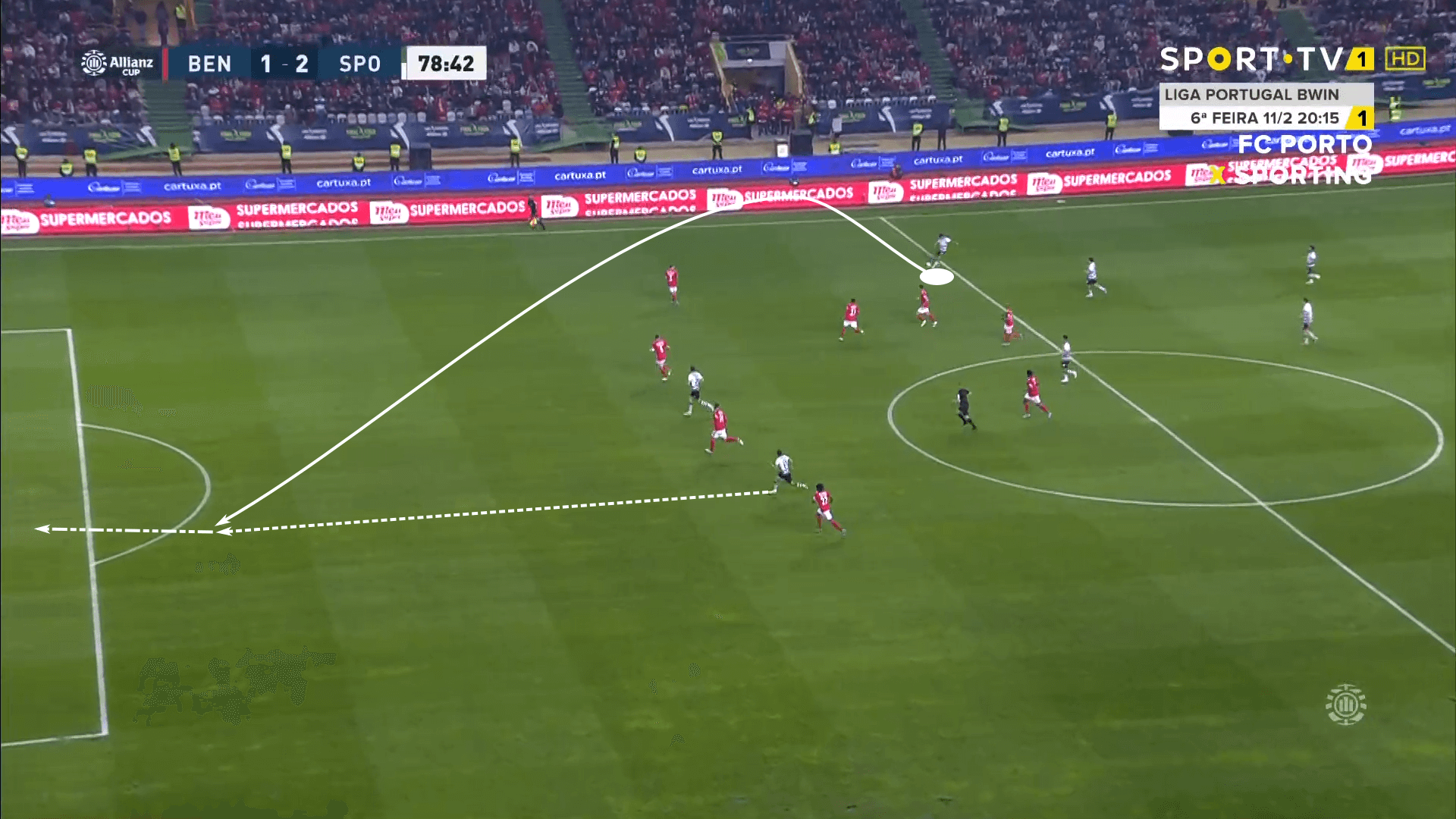
Porro’s wide positioning allows him to orient his body in a way that allows him to see the entire pitch. He’s a player with a very direct mentality, so while he will naturally look to attack on his near side, he extends his vision to the far side of the pitch very well. Benfica, Sporting’s arch-nemesis, was victimized by his vision and passing range in the dying minutes of the League Cup final. A beautifully lofted ball was perfectly placed into the path of Pablo Sarabia, whose goal proved to be the winner, paving the way for yet another trophy during Amorim’s brief tenure at the helm.
Before wrapping up this section on Porro’s attacking attributes, there are two other points worth mentioning. The first is that he’s at his best as Sporting attacks in the final third. His ability to get into the box and either create for others or to get a shot himself has been crucial to the club’s success over the past year and a half. With his quickness and agility, he manoeuvres the tight confines of the box exceedingly well, often getting off his delivery or earning a corner kick for Sporting.
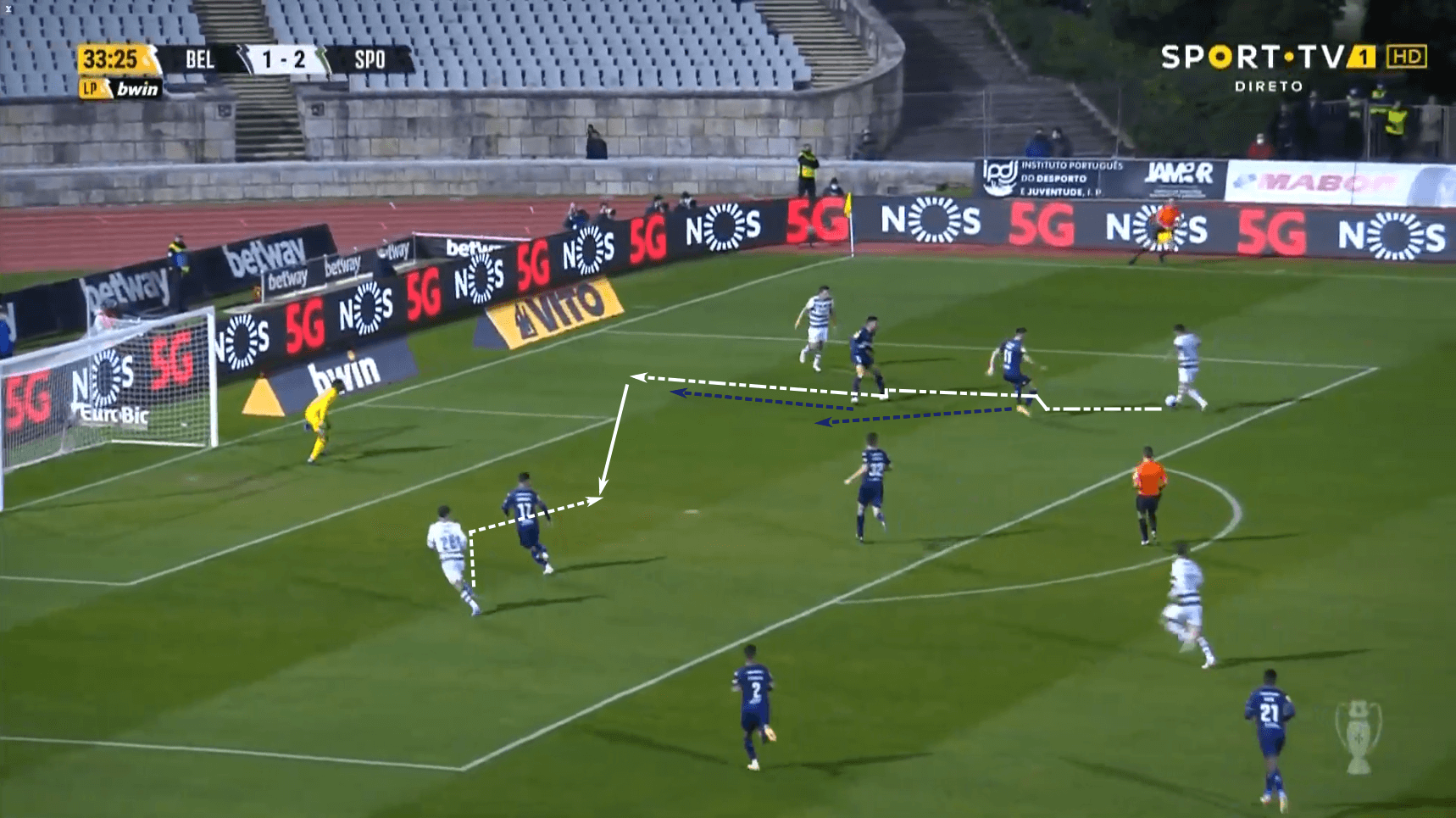
In our final image from the section, he manages to beat two Belenenses defenders in the box before sending a negative cross into the path of Pote. The young marksman uncharacteristically put the shot over the crossbar, but the sequence was a sign of bigger things. One is Porro’s dynamism in the final third, including in the box, and the other is the understanding he has developed with Sporting’s forwards in a very short span of time.
That second point I mentioned that’s worth noting…is that Porro can finish. With six goals in 43 league games for Sporting, he’s one of the better outside-backs and wingbacks in terms of getting into scoring positions and finishing off his chances. While that’s not as important as his creative qualities, it’s a luxury he brings to the Portuguese champions.
Analysis of Porro’s defensive work
That last section started with a data analysis profile showing Porro’s percentile ratings relative to outside-backs and wingbacks in the Portuguese League. You recall half of his stats from those first two sections were in the 90th percentile or better. In over 25% of those categories, he is the league’s top performer at the position.
Is attacking statistics are excellent, but the defensive statistics are a mixed bag. He’s serviceable in aerial duels, rating just above the 50th percentile, but he rarely engages in them, averaging just 1.17 per 90 minutes to go with a 50% success rate.
One of the positives is his possession adjusted interceptions per 90 minutes. He absolutely shines here, rating in the 80th percentile for the league with 7.85 P90. His 1.47 fouls P90 are slightly above average, but for a possession-dominant side like Sporting that does have to commit tactical fouls to defend against counterattacks, there’s no need for concern here.
Instead, it’s the defensive duels categories that are troublesome. On a 90 minute basis, Porro engages in more defensive duels than almost any other outside-back or wingback in the Primeira Liga with 9.97. That’s the third-highest mark in the league.
When paired with his 52% defensive duel success rate, which falls in the bottom 20% of the league, what we have is someone who’s highly involved in the defensive side of the game and struggling for success. When a player’s defensive statistics show high levels of interaction and low levels of success, you have to question whether opponents have spotted a weakness in the system. That’s where I found my launch point when analysing Porro’s defensive qualities. I wanted to figure out if he was in fact being targeted or if the skewed numbers were perhaps down to other circumstances, such as being caught in bad positions in the counterattack or defending in disadvantageous areas of the pitch, especially when covering lots of ground.
Porro has missed 12 matches this season due to muscle injuries and a bruised knee, which has made room for Esgaio to pick up starts on his preferred right side. Looking at the direct comparison, Esgaio averages 17% fewer defensive duels P90 (8.27) and enjoys a 65.25% success rate, a 20% improvement on Porro’s numbers. While it’s not quite enough to say opponents target him, especially since he’s typically more engaged in the attack than Esgaio, there is certainly a need to investigate the discrepancies.
One important key to this tactical analysis is to remember that Porro is essentially the right-back in a back five when Sporting defends. Amorim’s tactics have him drop off to create a pressing cue with the pass into the wings.
However, the higher up the pitch the opponents get, the more Porro’s job description changes. When opponents plane to the outside-backs or wingers in their defensive and middle thirds, Porro’s deeper starting point allows him to keep play in front of him and step forward to press the opposition. As the opponents progress into their final third he still tends to focus on that forward movement rather than understanding he must know to prioritise the space behind the backline.
Leões supporters will certainly not want to dwell on Sporting’s heavy first-leg defeat in the Champions League Round of 16 to Manchester City, but there’s value in understanding how Manchester City got their goals. Unfortunately, Porro did play a role in a couple of them.
Analysis of the match showed both Sporting’s inability to protect the half-spaces of the box and the vulnerability of the relationship between the wingbacks and the wide centre-backs. When defensive breakdowns occur, there’s rarely one player at fault, which is certainly the case in Sporting’s defeat to City, but the EPL side did expose some issues in the tactics.
In the build-up to the first City goal, Bernardo Silva, another Benfica academy product in the Cityzens’ squad, made a well-timed run behind the Sporting backline. Matheus kept him onside, but we’re going to focus on how City was able to access the half-space so easily. Specifically, we want to examine Porro’s role in the play. First, he was caught in no man’s land, neither pressuring the ball nor preparing for Silva’s run. To make matters worse, Gonçalo Inácio was late to offer cover.
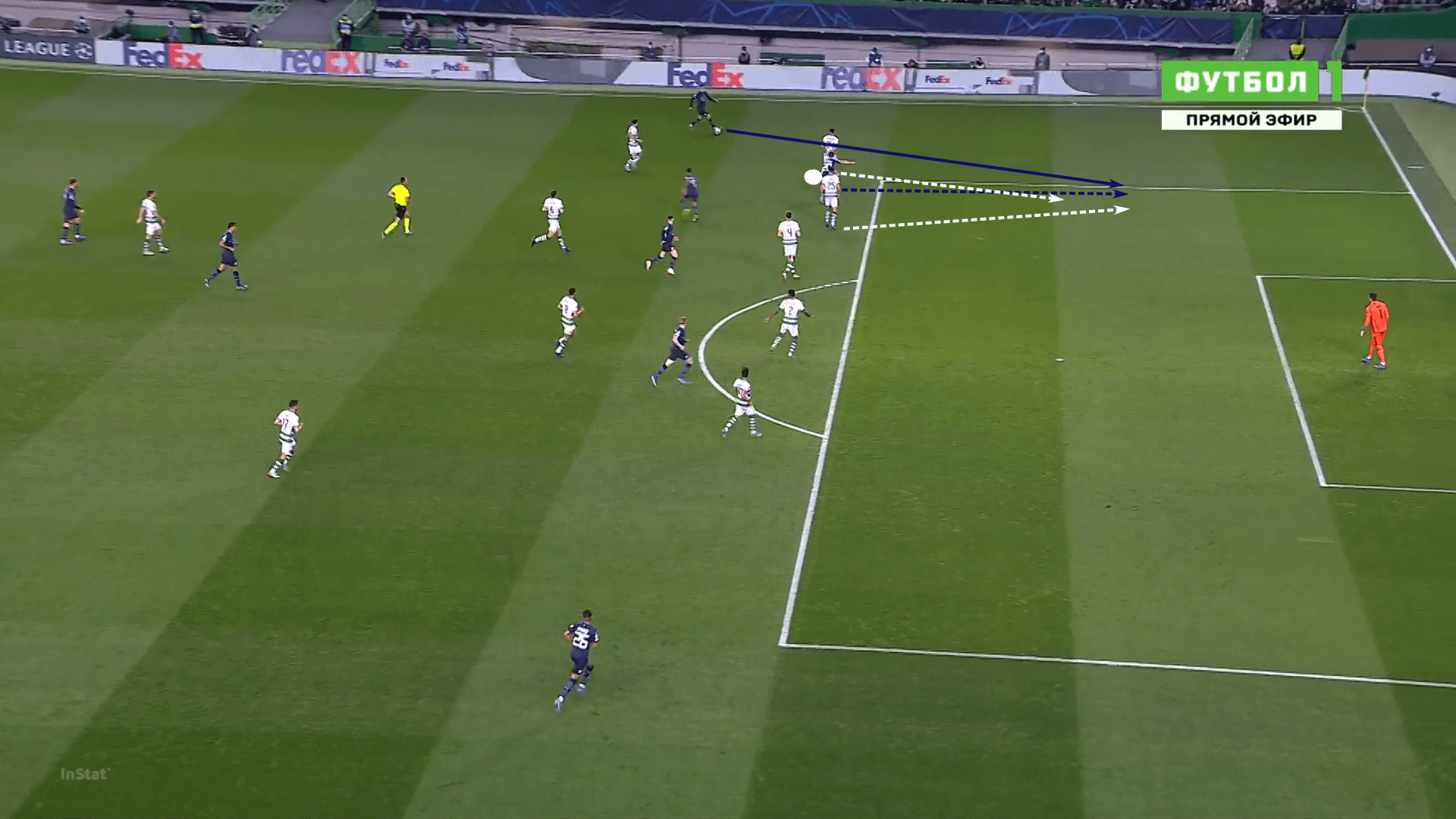
Once the ball is played behind, Porro’s recovery run is poor. Initially, he tracks the run of Silva, failing to read the late movement of Inácio. Ideally, Porro will see the switch in roles and move centrally.
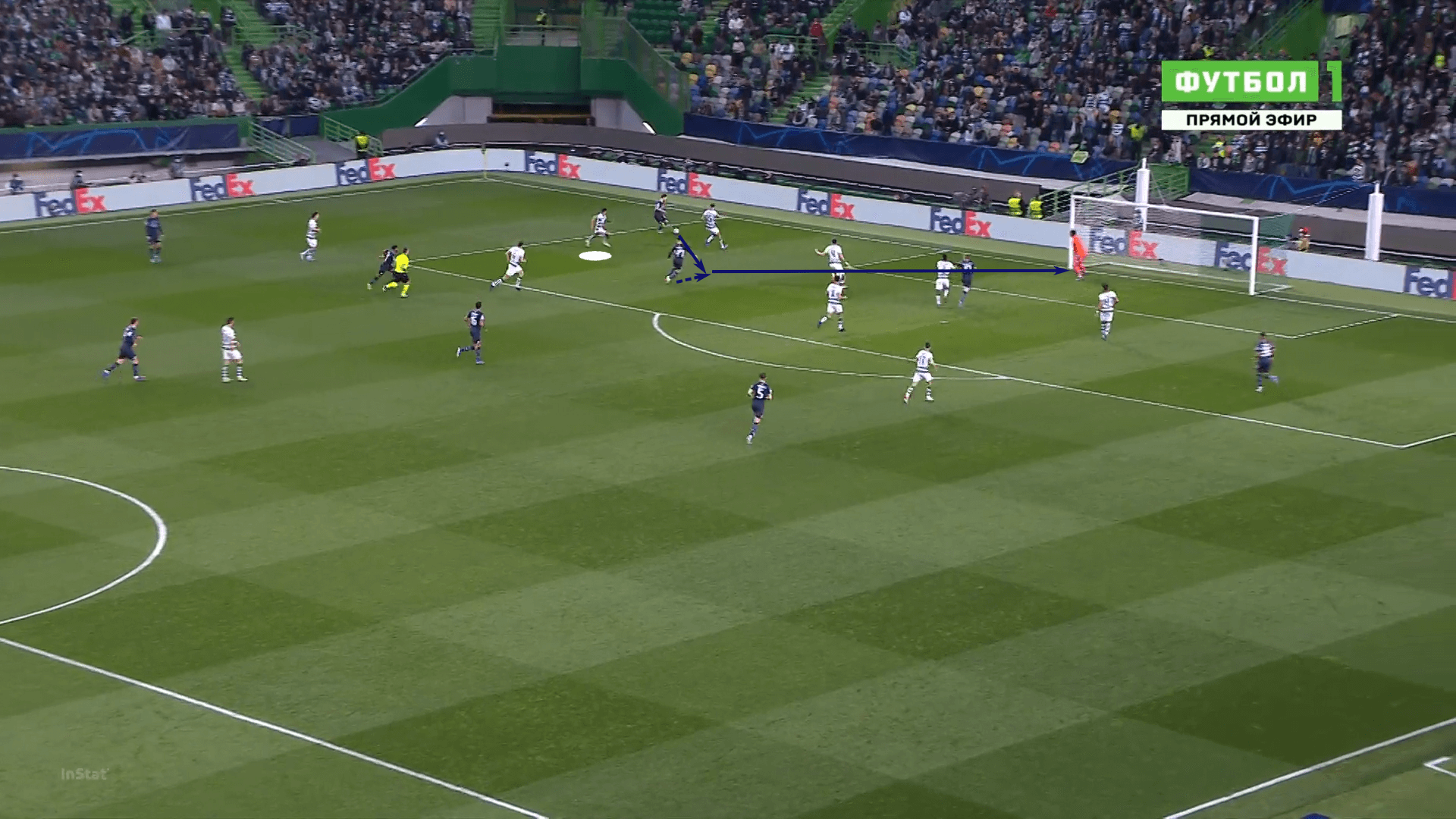
That doesn’t happen soon enough, allowing Silva to make a simple, negative pass into the path of Phil Foden. The English International took a first-time shot that was saved by the goalkeeper, Antonio Adan, but the rebound fell to the feet of Kevin De Bruyne, who had just managed to stay inside from the initial shot. His pass to Riyad Mahrez gave City the early lead.
Several small mistakes contribute to this goal. Porro’s fault is with the initial indecision and the poor recovery run.
Let’s focus on the indecision. Initially, it looked like the emphasis was to protect space behind the backline, which is perfectly reasonable since City likes to attack the box through the half-spaces before sending the final ball. Sporting looked well set to defend against that threat. However, as the pass is sent, both Porro and Inácio are behind the play. My initial reaction was one of surprise because it looked like they were well-positioned and had the correct body orientation to defend against that exact pass. Only the timing of the pass was yet to be determined. The lack of recognition of the “when” is the first issue, the second being the poor recovery run. However, if you get the first thing right, the second likely becomes less important, if not irrelevant.
That case against Manchester City featured a run through Porro’s blindside. Against Borussia Dortmund during the Champions League group stage, we have an example of poor defensive work during an overlapping run.
Julian Brandt was in possession with Nico Schulz making the overlapping run. To his credit, Brandt pins Porro before slipping Schulz behind the Spaniard. It’s a textbook overlap, at least from an attacking standpoint. Defensively, the sequence is a bit of a mess.
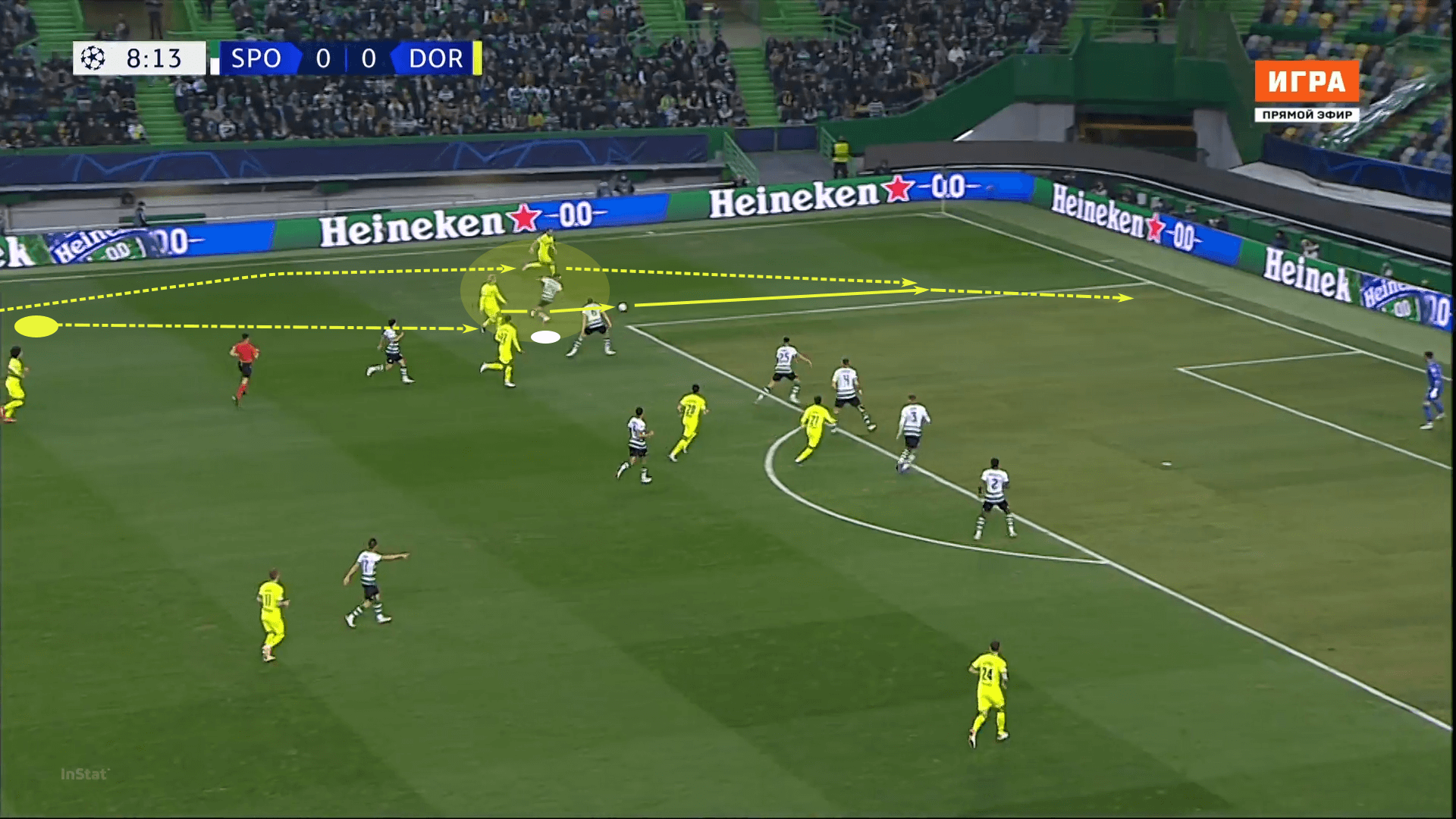
First, Porro has to understand the pass is coming. Rather than preparing to confront Brandt, his focus should be slowing the attack while maintaining distance from the first attacker to better prepare him to track the run of the second attacker. Secondly, the partnership with Inácio comes into question again. As Porro steps forward, Inácio must step into a deeper position in expectation of the pass. He must understand that this is a moment to key in on the transition from second to first defender roles.
One interesting thing that stood out in the film was a difference in Porro’s effectiveness when defending a 1v1 with secondary players involved versus a true 1v1. In the four-part image, the top two show Porro defending against Benfica. The event is a 1v1 duel, but an overlapping runner is complicating the scenario. If you zoom in on the image, Porro’s wide defensive posture and poor timing in the tackle are very clear. This is just a guess based on this sequence and others like it, but my thought is that Porro wants to engage 1v1 before the overlapping runner has a chance to attack space. In a sense, he pre-emptively defends the pass by using a tackle before the duel has actually started. He’s forcing the issue.
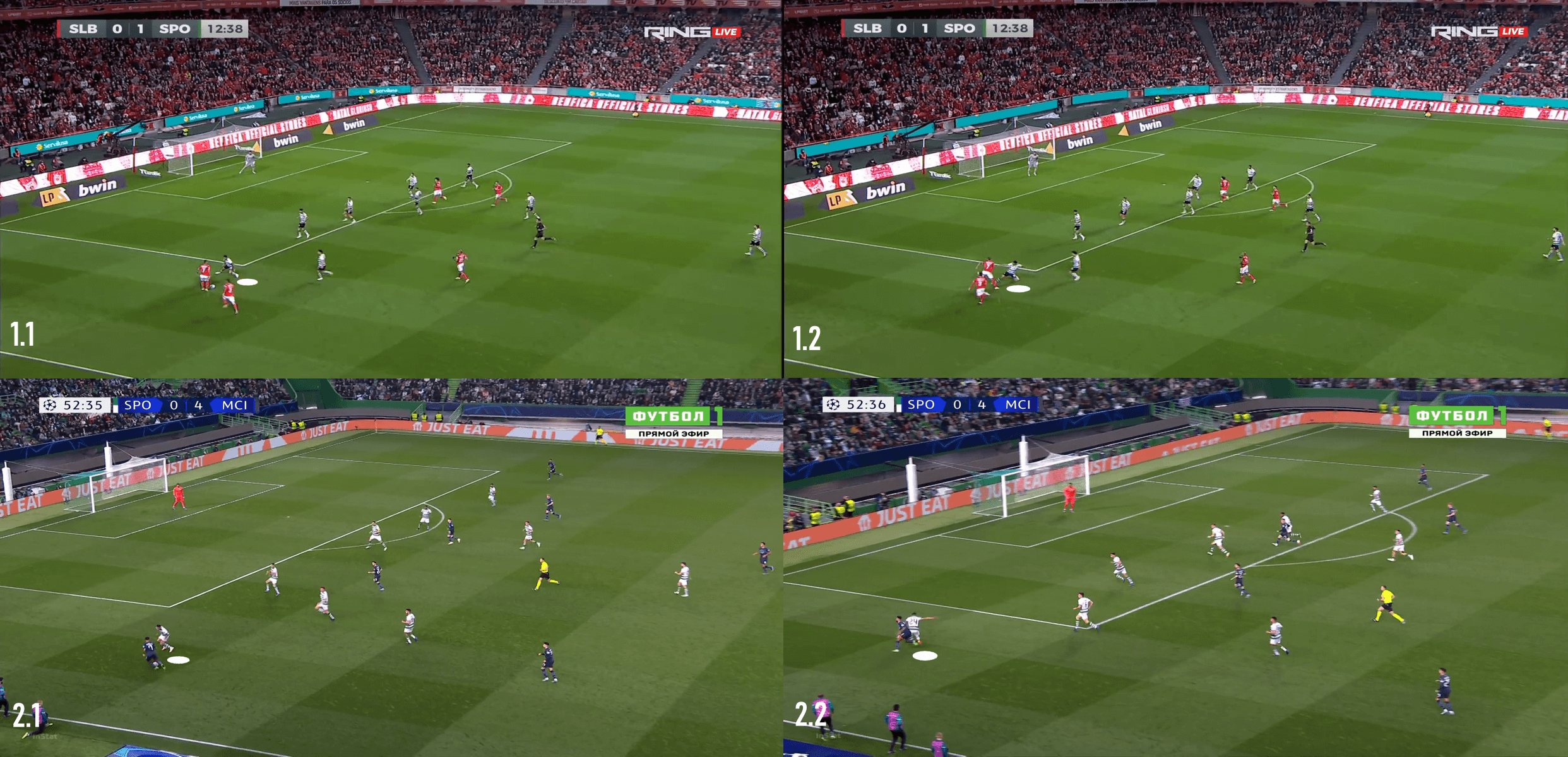
The two pictures on the bottom represent a true 1v1. Raheem Sterling has the ball. The second attacker is blocked off and Porro’s cover defender is not prepared to step into action. Without the additional stimulus, Porro can now focus his attention on Sterling’s movements. The result is a textbook side block tackle and 1v1 duel win for the Sporting right-wingback.
In true 1v1 scenarios, Porro’s defending was typically very good. He’s a very quick player with very good agility, so he’s up to the task physically. The biggest difference between the two scenarios is that he was able to focus his attention strictly on the movements of the one player rather than trying to defend against a scenario with multiple possible outcomes. He’s a very aggressive player, so it’s those occasions where he’s better off exercising patience, taking a more conservative approach to protect the space behind him while delaying the opposition’s attack, that he struggled with most. Fortunately, this is something he can fix.
What’s interesting is that he does show good awareness of pressing cues. He’s especially adept at starting deeper and moving forward quickly as intermediate to long-range passes into the wings are played. We saw this in Sporting’s 3-1 victory against Benfica in league play. As the pass was played forward, he caught Alex Grimaldo off guard with his quick pressure on the ball. Porro covers ground very well, which is another reason for his aggressive approach. He seems very confident that he can make those recoveries higher of the pitch.
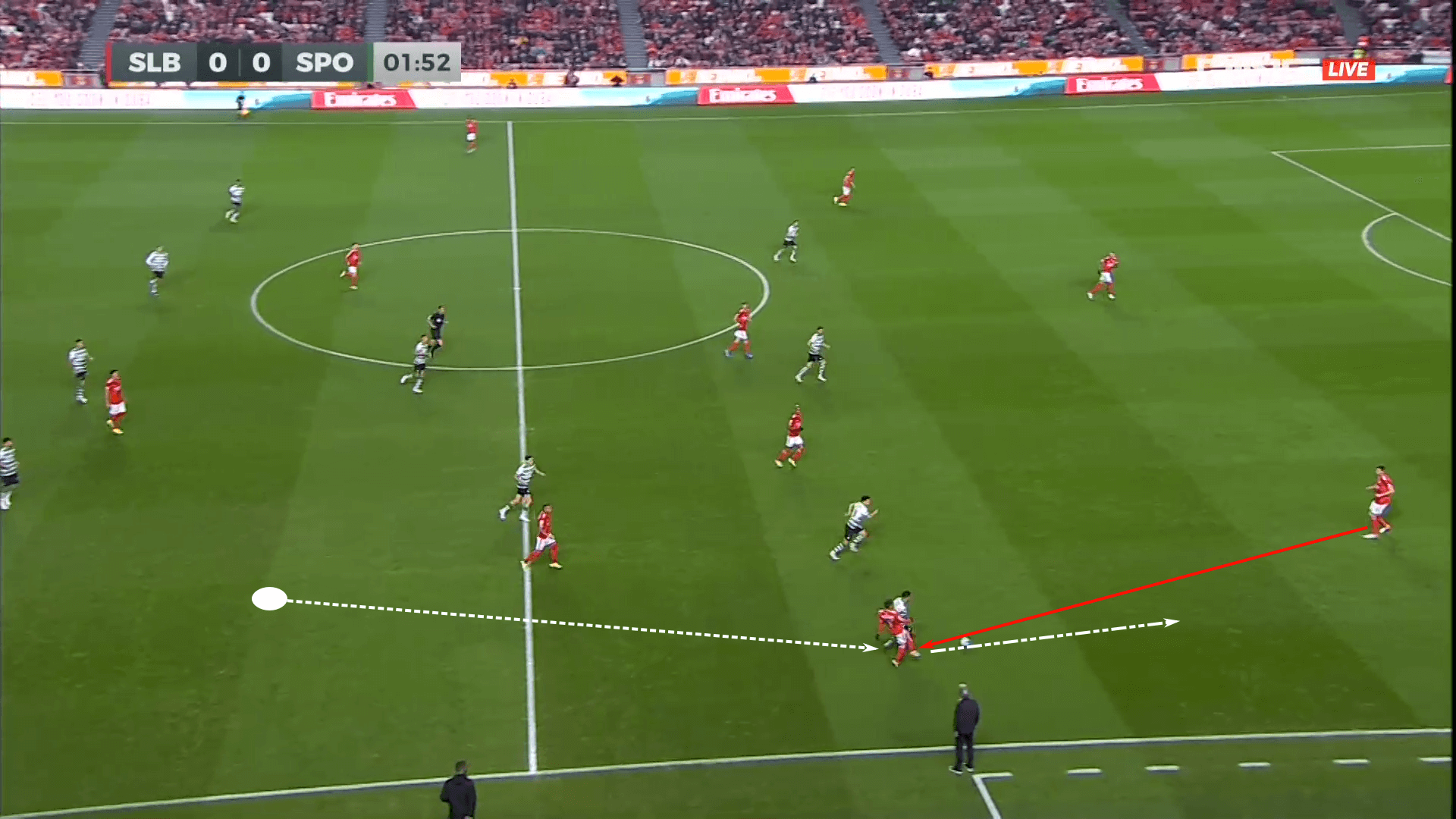
With Sporting’s tactics typically placing Porro as the first defender when the ball is out wide, I did manage to find situations where he has switched with the centreback and has participated in a scenario that more closely resembles the role a right-back would play in a back four. This one happens against Boavista.
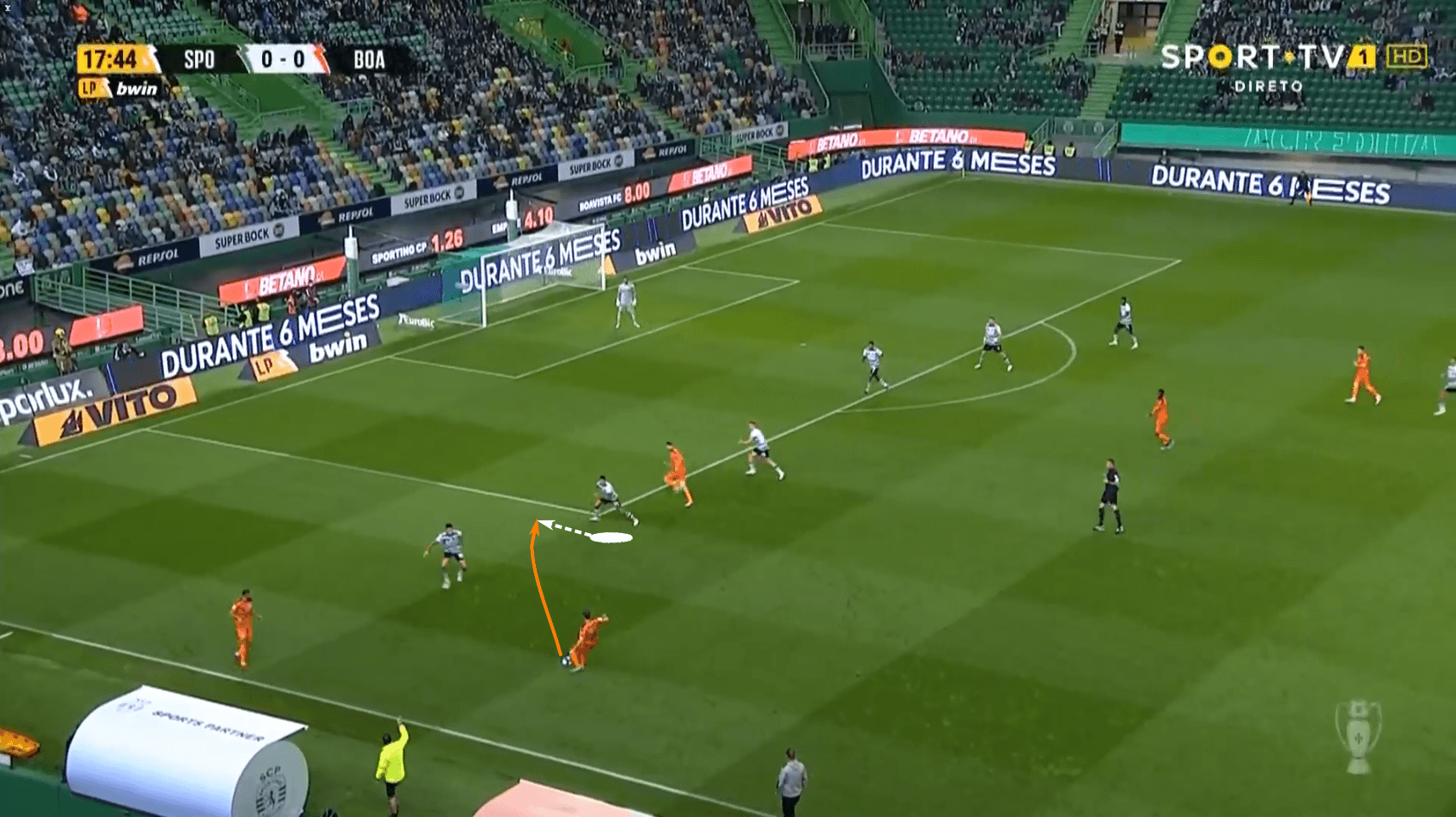
He and Inácio have switched roles, resembling a situation in which a right forward in a 4-3-3 has dropped deep to defend. From a more functional right-back role, Porro does well to read the run into the half-space, anticipate the pass and register the recovery. You could argue you looked more comfortable in this scenario than he does when defending is the widest player to the right in the back five.
This is easily the most complicated part of the analysis. Porro has some excellent defensive qualities, especially his anticipation that leads to interceptions and his defending in true 1v1 scenarios. He is still only 22 years old, so the Spanish international has the room to grow and the time to do so. If he can correct his read of play in overloaded scenarios and read the cues that signal when the opponent intends to play behind him, he can make tremendous improvements and his defensive performances, becoming an all-around performer.
Is Porro ready for the top?
At the moment, Porro is on loan at Sporting Club from Manchester City with an option to buy. The terms are reasonable, so it would be surprising if Sporting does not trigger the £7m buyout. Should Sporting make the signing permanent, there’s talk of a €45 million release clause and €20 million buy-back for City. Simultaneously, there are rumours that Real Madrid are interested in the player, viewing him as the successor to the injury-plagued Dani Carvajal.
Running Porro’s 2021/22 campaign numbers alongside those of outside-backs and wingbacks from the other top six leagues in UEFA, Porro’s attacking numbers remain largely the same while his defensive efficiency improves in every regard except for defensive duels won percentage, which drops from the 18th percentile to approximately the 10th.
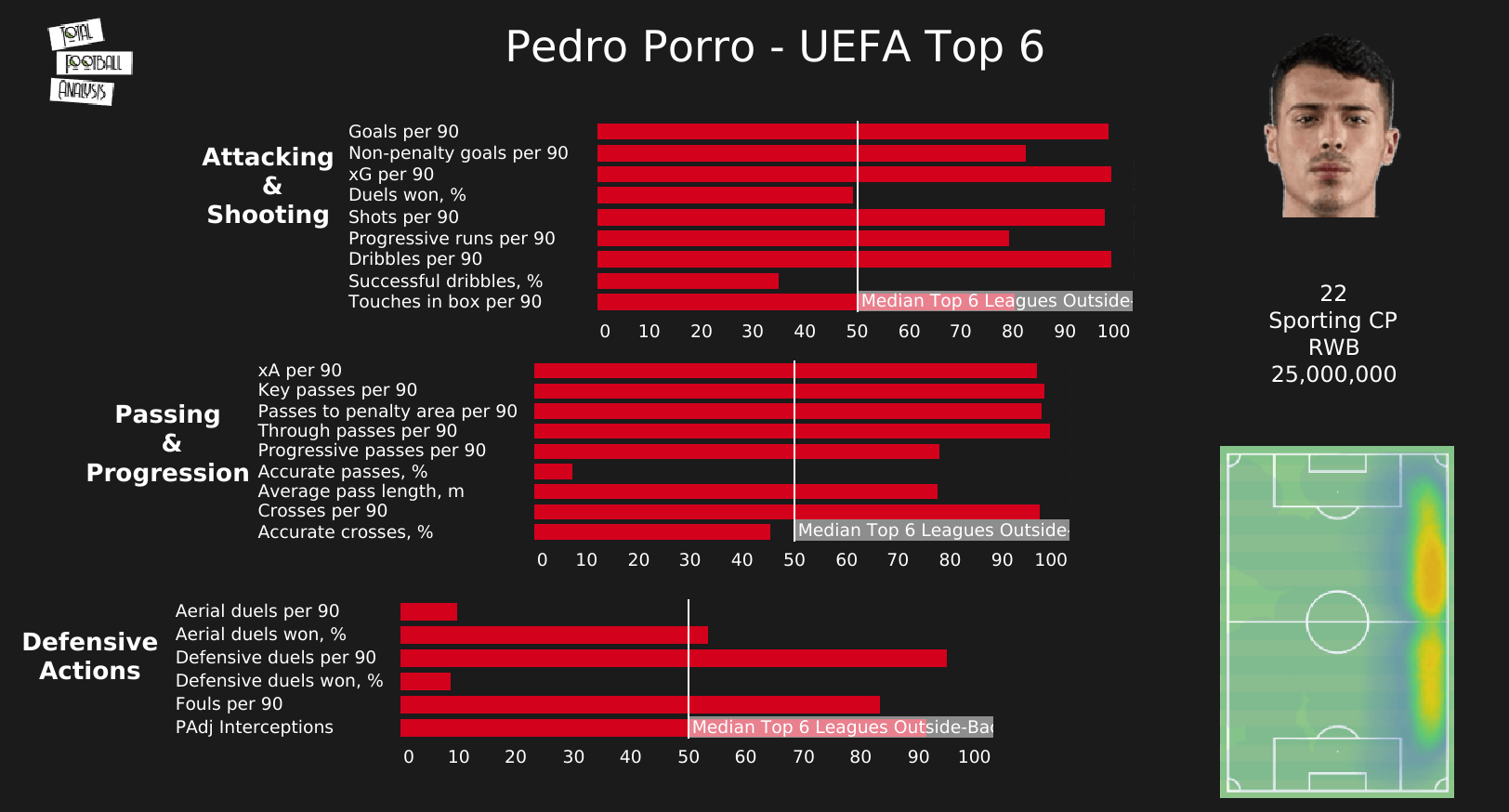
Though Sporting would undoubtedly like to keep their star right-wingback in the fold, there is demand for his services. Should a club like Real Madrid decide to pay the €45 million release clause, Sporting’s financial situation would obligate them to let the player leave rather than renegotiate his contract. If he does leave Amorim’s 3-4-3 tactics, he would likely return to his role as a right-back in a four-back system, especially if he returns to Madrid.
I say returns because he did represent Rayo Vallecano during his youth career. He also had a 2-year stay at Girona and a one-year loan at Real Valladolid, so he does have experience in La Liga. If Real Madrid is his next destination, they will take solace in knowing that he has historically played as a right-back rather than a right midfielder or right-wingback. Looking at his heat map from the Real Valladolid spell, we do see a very different one from his current campaign with Sporting. Rather than the wingback position that he has come to know, his positioning during the 2019/20 season was played in a much deeper part of the pitch.
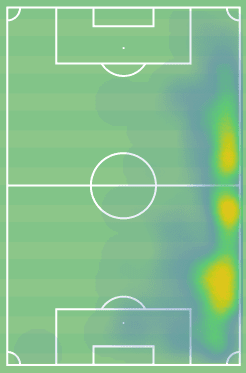
Now, that assurance that he has played on the right side of a back for in previous seasons does not override his performances during his Sporting tenure. In league play, his numbers are frequently the standards setters.
But what do his Champions League numbers look like?
Sporting has had a very difficult Champions League schedule. In addition to the Round of 16 draw against Manchester City, they were also in a group featuring winners Ajax, third-place Borussia Dortmund and fourth place Beşiktaş. At the time of writing, Ajax has only conceded 10 goals between Eredivisie and Champions League play.
Let’s look specifically at crossing and defensive actions. First, in terms of crossing, Porro’s 3.26 crosses per 90 minutes are well below his league output, but still above average for the competition. It’s his 18% completion rate that’s disappointing, especially in comparison to his 33.33% completion rate in league play.
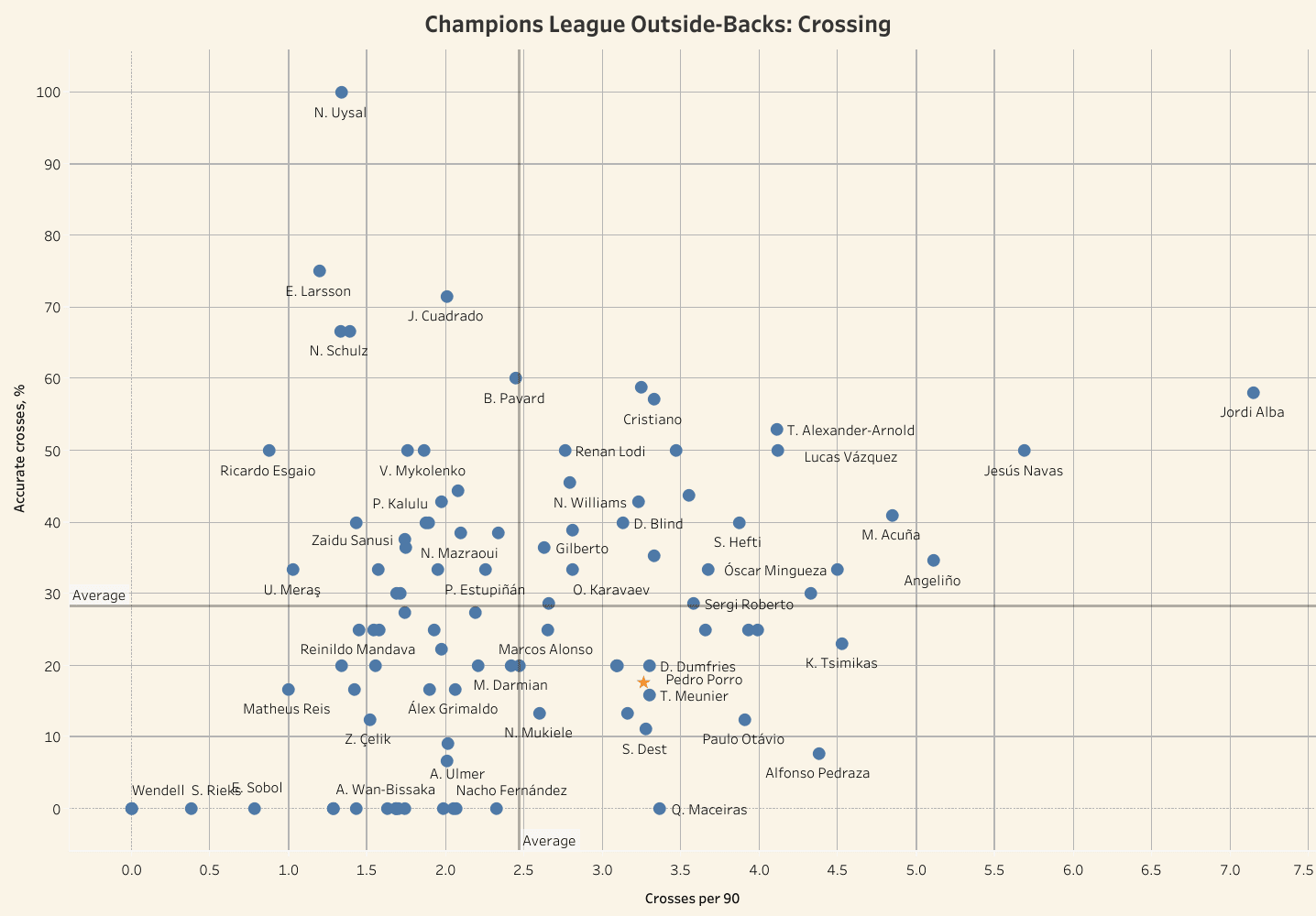
In terms of defensive actions, his possession-adjusted interceptions per 90 minutes saw a steep drop to 4.76, well below his league average of 7.85. His defensive duels saw very little change, but the combined output places him in the bottom right quadrant, which consists of the lowest performers in the two categories.
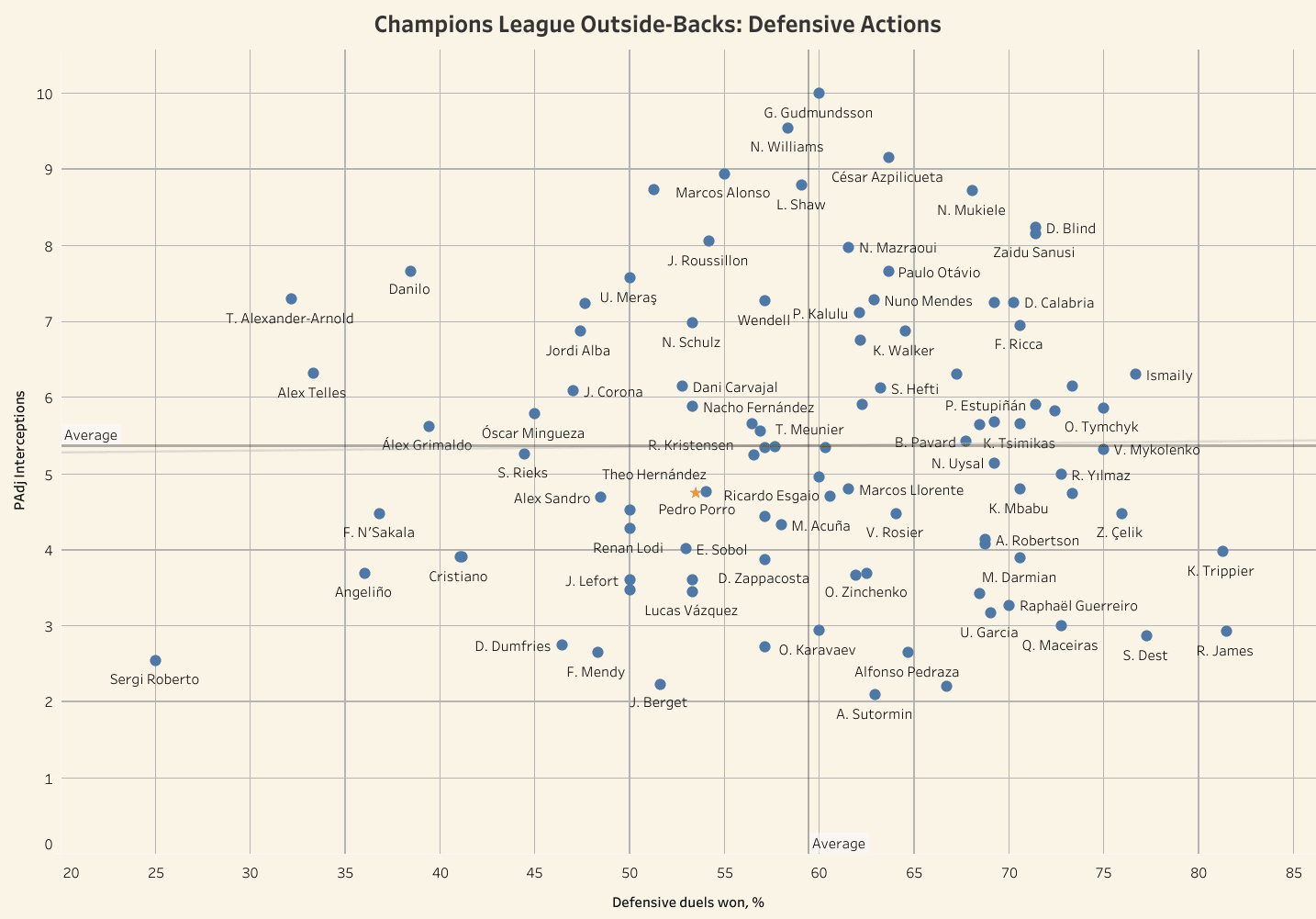
If Porro does leave Sporting in the near future, either a Manchester City buyback or Real Madrid transfer seem like the likeliest outcomes. Having an idea of his potential landing spots helps us place his Champions League statistics relative to the outside-backs on those two teams.
Ultimately, Porro’s crossing accuracy is the biggest disappointment, followed by his shot assists P90, but other than those two categories, his stats range from slightly below average to well above average.
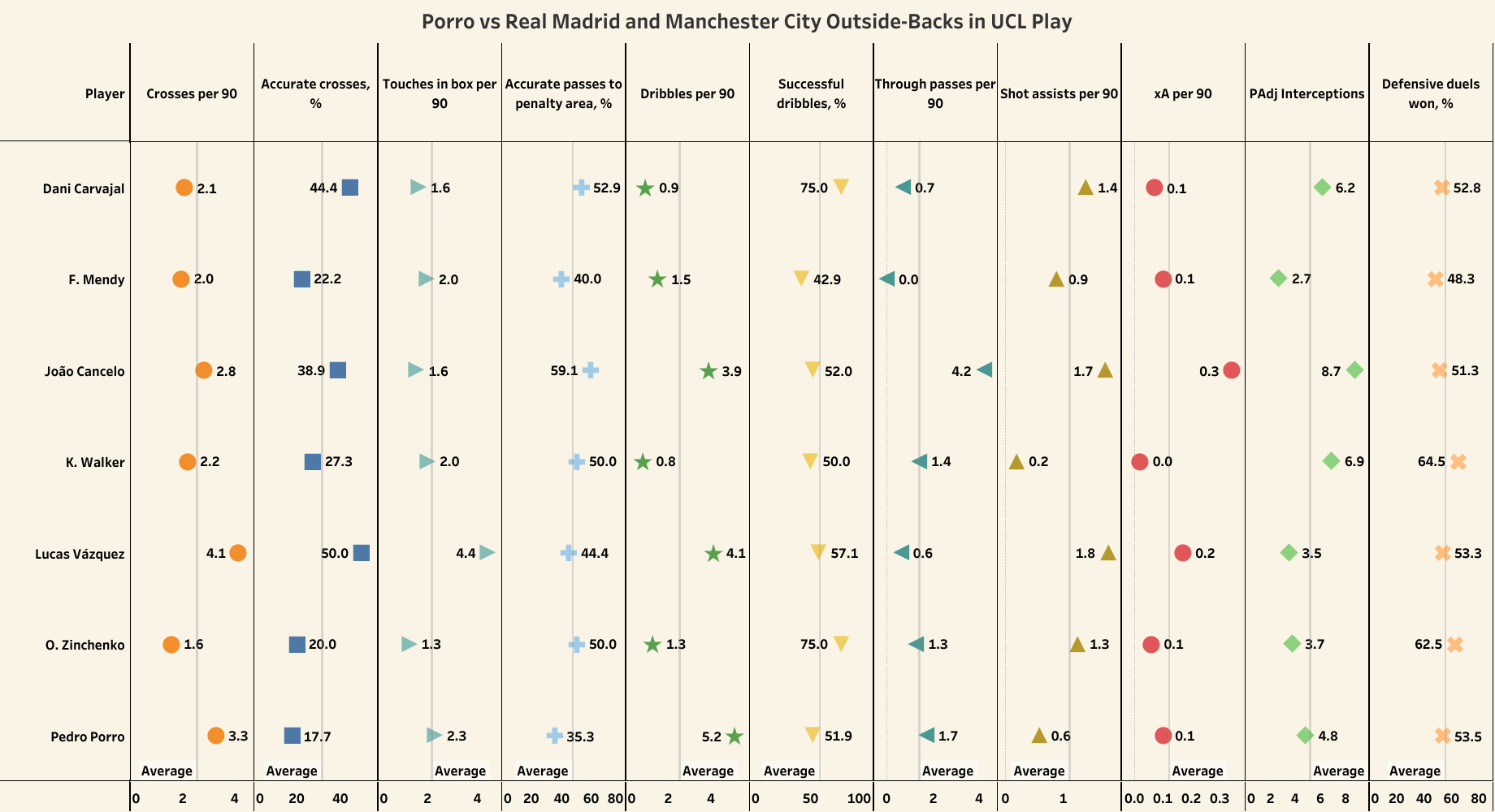
When transferring, you don’t necessarily have to be the best player on the market, you just have to be better than the guys the team already has. While that verdict is still up in the air, our limited data from the Champions League at least suggests that his performances on club football’s grandest stage are very similar to those of the Real Madrid and Manchester City outside-backs. Cancelo is the one player who runs away from the pack in multiple categories. Otherwise, Porro’s numbers do not look out of place at all.
Conclusion
Porro has made a name in Portugal as a premier wing presence. With the ability to play either is a right midfielder, right-wingback or right-back, he offers the tactical flexibility to fit into Sporting’s 3-4-3 or into a traditional four-back system.
Though some improvements are needed in the defensive area of the game, Porro has justified his time in the spotlight with his attacking upside, physical qualities and defensive work rate. He’s thriving in Portugal and enjoying life under Amorim. Should Sporting catch Porto and seal a second consecutive Primeira Liga title, they’ll need Porro to remain healthy the remainder of the season and continue to produce both in attack and defence.
The spotlight’s on Sporting and the young Spaniard, and it’s well-deserved.

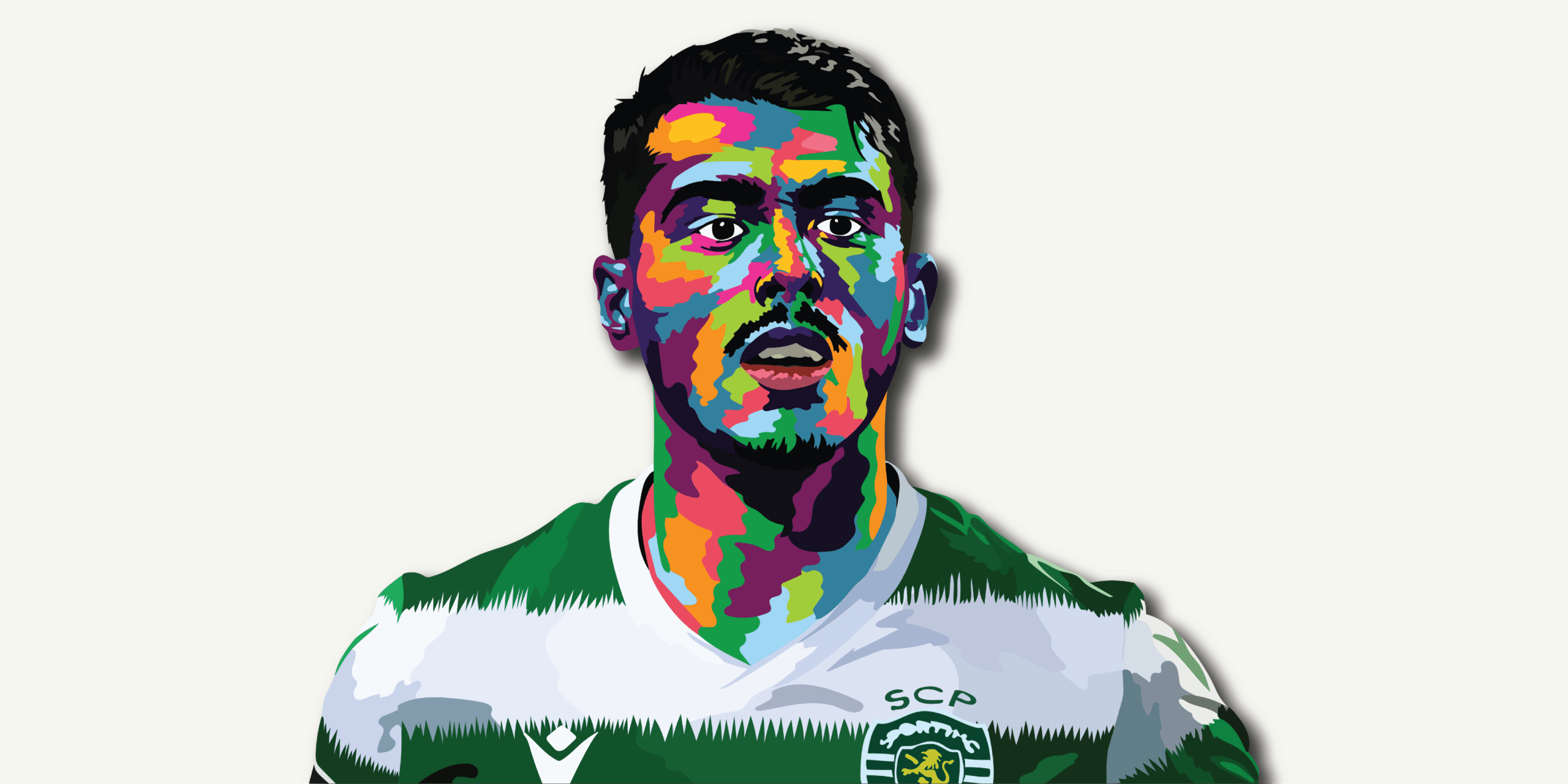



Comments